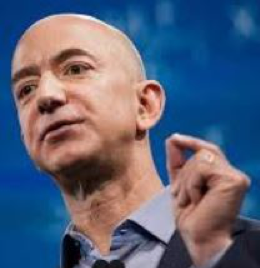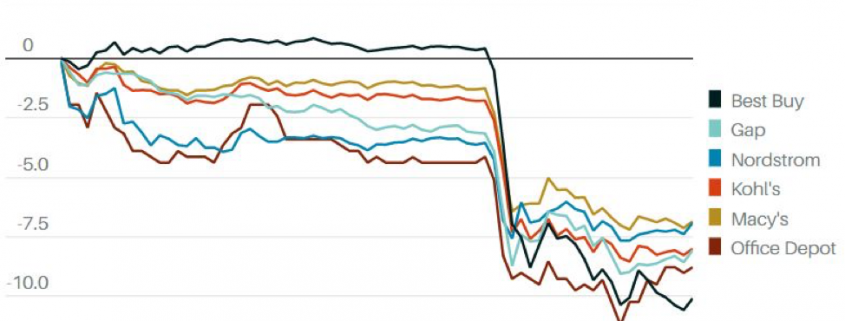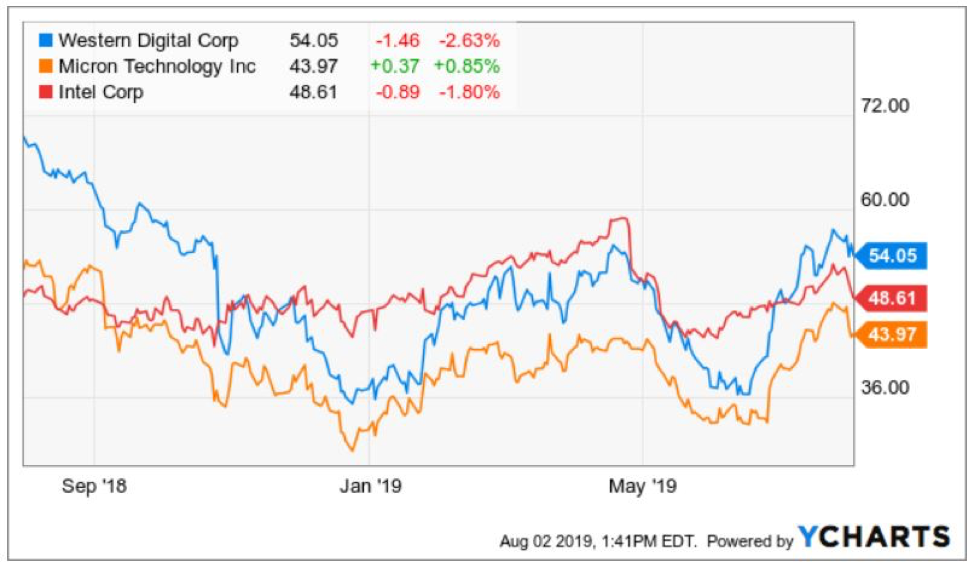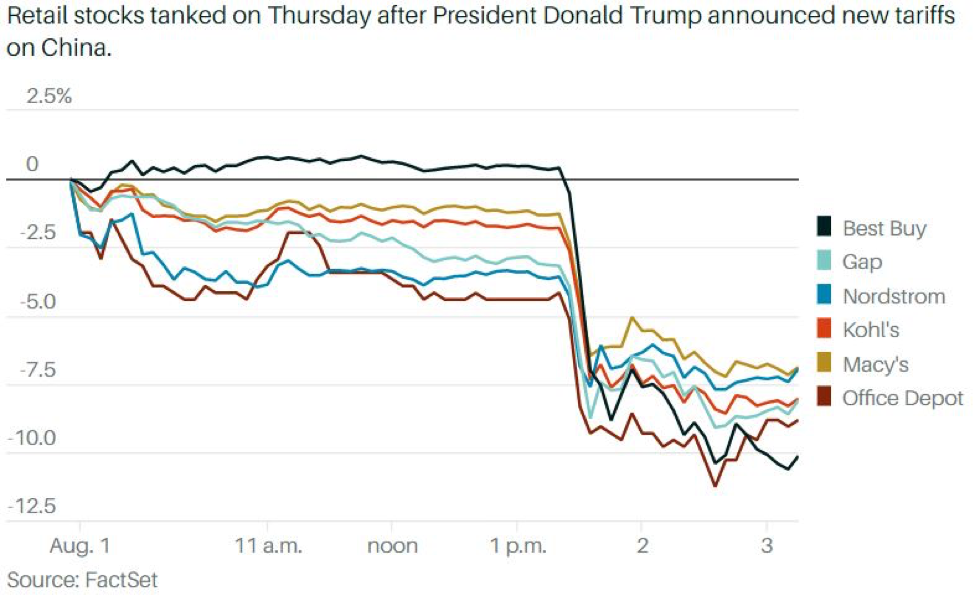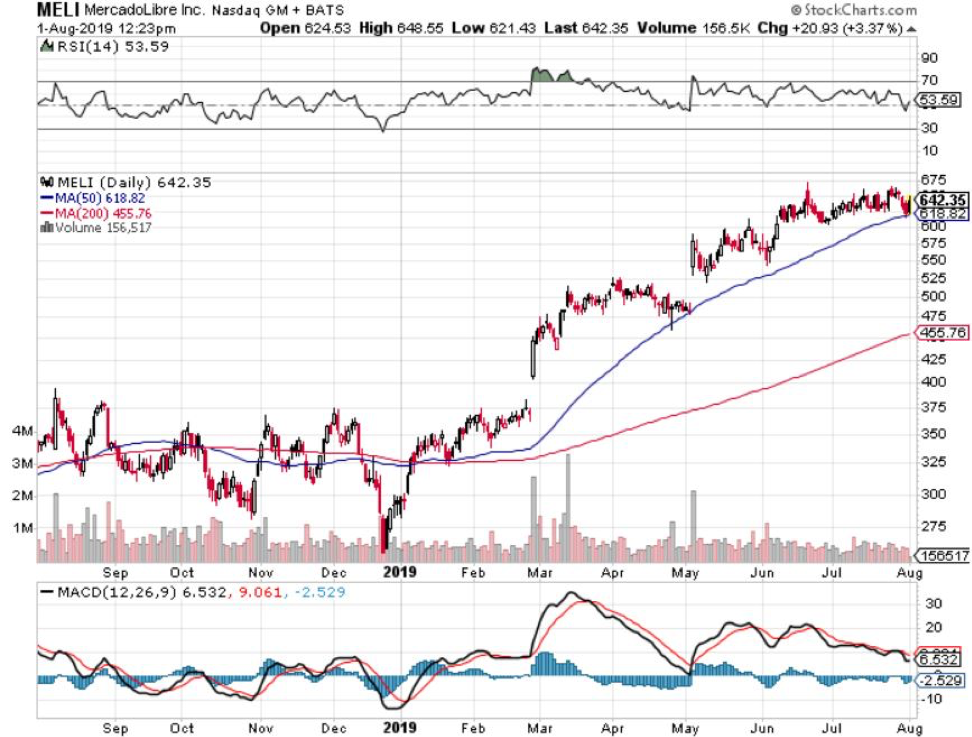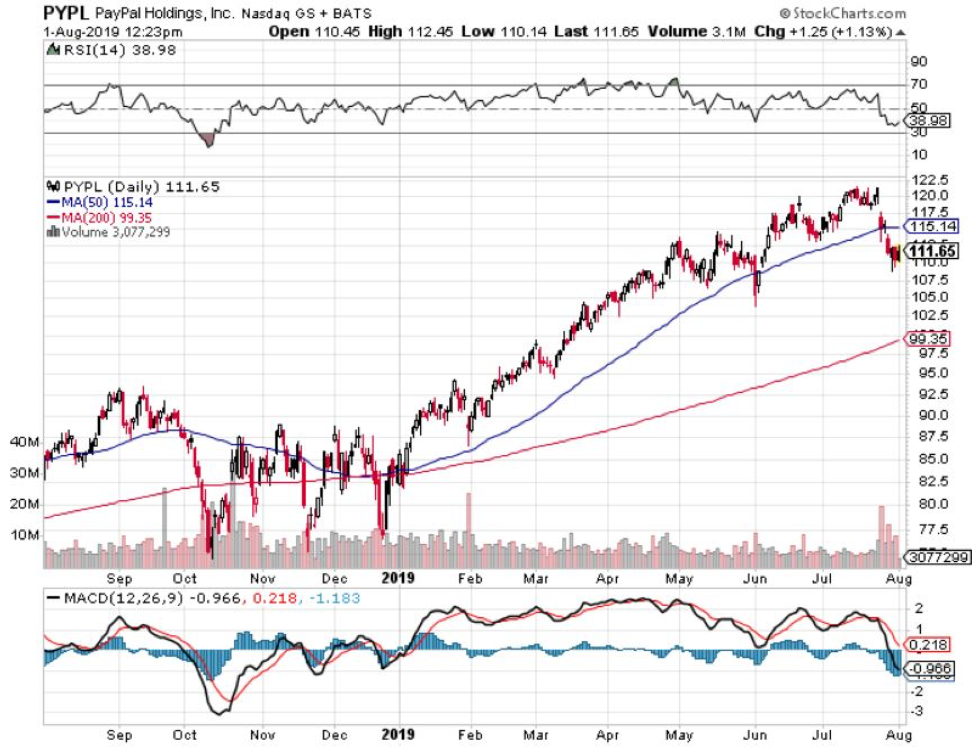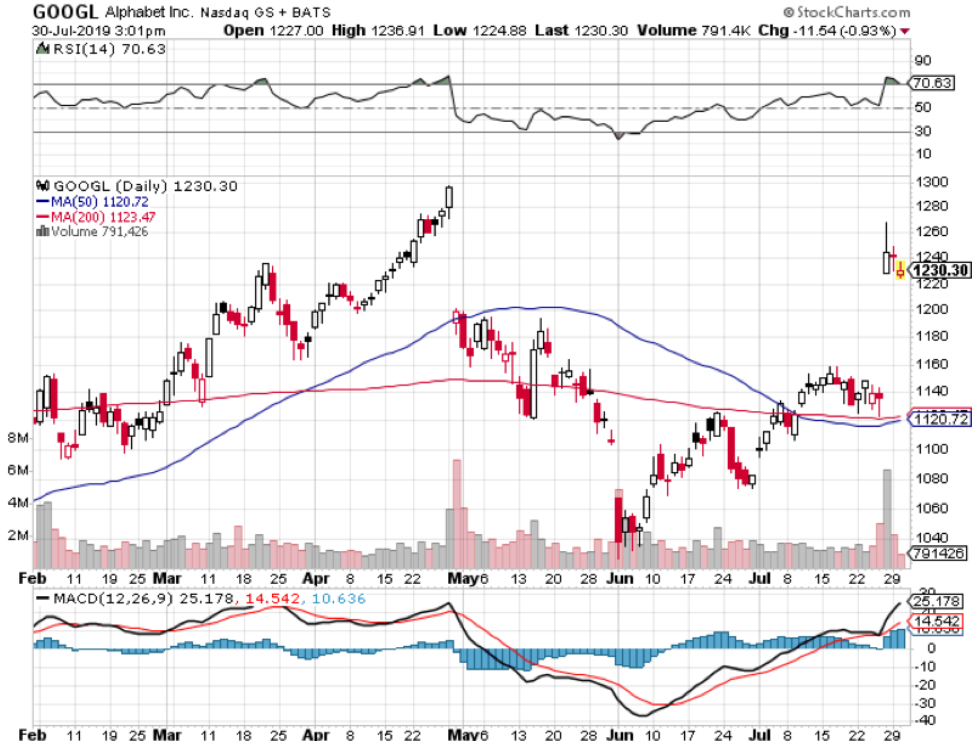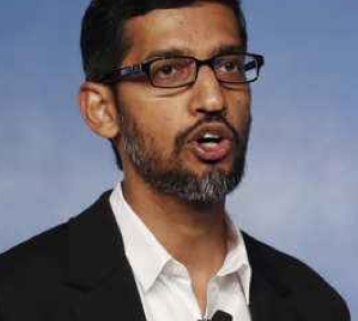“One of the only ways to get out of a tight box is to invent your way out.” – Said Founder and CEO of Amazon Jeff Bezos
Mad Hedge Technology Letter
August 5, 2019
Fiat Lux
Featured Trade:
(THE CHINA TARIFF BOMBSHELL AND TECHNOLOGY),
(AAPL), (NVDA), (INTC), (MU), (WDC), (BBY)
With one little tweet, the state of technology and the companies that rely on the public markets that serve them went haywire.
U.S. President Donald Trump levied another 10% on the $300 billion that had not been tariffed up yet compounding the misery for anyone who has any vested interest in trade with mainland China.
The tariffs will take effect on September 1st.
How does this shake out for American technology?
Any brand tech name that has substantial supply chain operations can kiss their stay in the Middle Kingdom goodbye.
If management didn’t understand that before, then it's clear as night that they need to shift their supply chain out of the reaches of the Chinese communist party.
The U.S. Administration tripling down on China being our archnemesis means that any sort of cross-border economic trade or cultural exchange will be viewed through the prism of warped geopolitics.
The U.S. President Donald Trump has in fact taken a page out of the Chinese playbook turning everything he sees and touches into a transactional tool for what he is pursuing at the time or in the future.
Specific companies facing the wrath of the tariffs are companies as conspicuous as Apple filtering down to the SMEs that make local business local.
Semiconductor chips are a huge loser in this new development as the price of electronic goods will rise with the tariffs.
If you want a name that lies in the heart of electronic consumer goods, then BestBuy (BBY) would encapsulate this thesis and unsurprisingly they were taken out to the back of the woodshed and taught a lesson dropping 10% on the news.
Any technology outfit that imports goods from China will be hit as well and this means semiconductor chips along the lines of Nvidia (NVDA), Intel (INTC), Western Digital (WDC) and Micron (MU) among others.
Chips are the meat and bones that go into end products like iPads and a slew of smart devices.
Demand will be hit because of the cost of producing these types of consumer products will rise.
The softness is showing up in the numbers with Apple’s iPhone revenue down 12% year-over-year.
Samsung of Korea also showed that this isn’t just an American problem with their semiconductor division’s operating profits down 71% year-over-year.
The Korean conglomerate is in a spat with the Japanese government over war crimes from the second world war causing the Japanese government to bottleneck the supply of chemicals needed to produce high-level semiconductor chips.
The export restriction will drag down SK Hynix display business who is one of the largest producers of DRAM chips and also a Korean company.
Consumers are also using their phones longer with Apple iPhone customers holding their device up to 4 years delaying the refresh cycle.
The company that Steve Jobs built will have to repurpose themselves for a brave new tech landscape that includes heavier regulation, trade tariffs, and device saturation.
When investors talk about the “low hanging fruit,” at this point, Apple isn’t one of them.
And if you think the services business is a cakewalk, ponder about how many apps and behemoths that spit out a whole lineup of apps.
Apple still has its ecosystem and should guard it with its life, this is the same ecosystem that can charge Google around $10 billion per year to slap on Google search as the primary search engine on Apple devices.
Expect tech to telegraph a deceleration in revenue for the last quarter and next year.
The tech environment is brittle at this point and uncertainty wafts in the air like a hot stack of pancakes.
“It's really hard to design products by focus groups. A lot of times, people don't know what they want until you show it to them.” – Said Co-Founder of Apple Steve Jobs

Mad Hedge Technology Letter
August 2, 2019
Fiat Lux
Featured Trade:
(THE GREAT LATIN AMERICAN INTERNET PLAY),
(MELI), (PYPL), (AMZN), (EBAY)
How do you get exposure to the e-commerce story in Latin America?
The best way to do that is to dive into Mercado Libre (MELI), meaning “free market” in Spanish, an Argentine company incorporated in the United States that operates online marketplaces dedicated to e-commerce and online auctions, including mercadolibre.com.
Mercado Libre was established as an Argentine company in 1999 and Founder & CEO Marcos Galperin, while attending Stanford University, acquired funding from HM Capital Partners co-founder John Muse to start his brainchild.
Mercado Libre received additional funding from JPMorgan Partners, Flatiron Partners, Goldman Sachs, GE Capital, and Banco Santander Central Hispano.
The company has used M&A along with organic growth to drive the company.
Relevant examples are of eBay (EBAY) buying a 19.5% stake in the company and then selling its stake in Mercado Libre in 2016, but the companies continue to expand eBay sellers into Latin America.
The cooperation remains strong with eBay opening its first branded store on the Mercado Libre marketplace from Chile in March 2017.
Mercado Libre has acquired iBazar Como, the Brazilian subsidiary of eBay's earlier acquisition, iBazar S.A.
The success culminated with becoming the first Latin American technology company to be listed on the NASDAQ, under the ticker symbol MELI.
The firm offers investors a way to invest in one of the fastest-growing e-commerce markets in the world.
The company has 280 million registered users out of 644 million people who live in Latin America.
The stock has soared 543% in the last five years making the firm one of the fastest growing e-commerce companies in the world by many metrics.
The main drag is that the valuation looks frothy at these price levels.
Mobile payments have mushroomed naturally because of its title, the "eBay of Latin America."
They can also claim to be the PayPal of the region, thanks to robust growth happening in the MercadoPago digital payments business.
In the first quarter, total payment volume rose 82.5% year-over-year.
Off-marketplace payment volume is up 194% – accelerating each and every quarter.
Off-marketplace payments now comprise 45% of the company's total payment volume, and management sees high penetration trends happening in certain areas.
PayPal (PYPL) have become huge supporters of MercadoLibre with an investment of $750 million into MercadoPago.
The deal will join the firms together to work on the shared vision to digitize the economy, especially for the underbanked, in Latin America.
It's a stamp of approval of Mercado's brand recognition in the region that PayPal chose to invest in the company instead of competing.
How fast is the addressable market growing?
Investors have been seduced by the company's impressive growth in payments, but the core marketplace business is still doing backflips.
Gross merchandise volume (GMV) expanded 27% year-over-year in the first quarter, driven by 70% growth in Mexico.
Brazil is the largest market and expanded GMV by 18% year-over-year in the quarter.
Management referenced supermarket items in Mexico and increasing apparel selection as two areas that are showing strong results.
Apparel is the fastest-growing category, up 79% year-over-year last quarter.
With signs that new development is headed in the right direction, new categories and the company expanding its logistics footprint, the market will definitely expand.
MercadoLibre can grow beyond the marketplace business to become a formidable fintech company.
As it expands into other services, Mercado is fortifying its strong brand across Latin America.
Even as Amazon.com (AMZN) enters the high stakes industry, Mercado's first mover advantage can’t be underestimated.
The stock is pricey so lay off it for the time being but add with any major dips.
“We're very simple people at Apple. We focus on making the world's best products and enriching people's lives.” – Said CEO of Apple Tim Cook
Mad Hedge Technology Letter
July 31, 2019
Fiat Lux
Featured Trade:
(TIME TO TAKE A BREAK WITH GOOGLE),
(GOOGL)
It’s time to take a breather.
That is after the 9% spike in Google shares.
The best way to describe results of late for Alphabet is a mixed bag for the company helmed by Sundar Pichai.
Things aren’t going bad but not great either.
I‘ll tell you why.
Alphabet undershot its top-line revenue by about $1.7 billion, a large miss that should disturb investors.
It’s definitely not the growth company it once was even though some elements of Alphabet are still growing profusely.
Nothing better epitomizes the state of Google’s ad cash cow with its cost-per-click on Google properties from Q2 2018 to Q2 2019 falling 11% showing that they are having a harder time charging customers for clicking their stuff.
But on the bright side, paid clicks on Google properties from Q2 2018 to Q2 2019 was up 28% demonstrating the attractiveness and stickiness of platforms such as YouTube and Google Search.
Two other bright spots were its in-house lineup of smartphones called the Pixel and cloud products, which helped this segment grow to $6.18 billion compared to $4.43 billion last year.
I am actually a huge fan of the Pixel lineup even though I go with an iPhone.
If I did own an Android, I’d choose the latest Pixel with the added bonus of the convenience of Google’s best in show software.
Google is coming out with their Pixel 4 later this fall.
Pichai has never dived into the finer numbers of the Google Cloud but he took the time to mention that its cloud division is now an $8 billion and growing business annually.
Alphabet plans to heavily hire an army of warm bodies tripling the cloud staff for their successful cloud unit which is poised to be a mainstay growth driver for Google.
Looking at the imminent future, there are a few bogies in the sky.
The Australian Competition and Consumer Commission is part of a growing chorus of domestic and international regulators looking to subdue Google’s big data businesses.
The best-case scenario is more fines in the billions of dollars and the worst case is shriveling access to certain lucrative end markets.
Alphabet has been hard hit by the trend of more stringent global data regulations, and this is just the beginning.
Facebook appears as if it's in a deeper quagmire with multiple regulatory commissions state side smelling blood in shark-infested waters.
There is part of the argument that these practices stem from Alphabet being too dominant and there is some truth in this.
They are literally gunning for the entire internet whether it be travel or eCommerce.
I would say from my experiences with Alphabet that they do push the threshold a tad bit far.
They probably do not need to preinstall YouTube and Google Chrome on Android Devices without the inability to delete them.
If you have tried to delete these apps from Android devices, you are stonewalled, but I do hold the view that users will naturally come to the conclusion these apps are utilities and would download them if not preinstalled in the first place.
Alphabet should be more comfortable in its expertise and leadership position.
After a rapid run-up in share appreciation, Alphabet is due for a short-term pullback which could materialize soon because of regulatory fears.
Traders should look at some short duration bear put spreads on Alphabet.
I am long-term bullish Alphabet.
“The right moral compass is trying hard to think about what customers want.” – Said CEO of Google Sundar Pichai
Legal Disclaimer
There is a very high degree of risk involved in trading. Past results are not indicative of future returns. MadHedgeFundTrader.com and all individuals affiliated with this site assume no responsibilities for your trading and investment results. The indicators, strategies, columns, articles and all other features are for educational purposes only and should not be construed as investment advice. Information for futures trading observations are obtained from sources believed to be reliable, but we do not warrant its completeness or accuracy, or warrant any results from the use of the information. Your use of the trading observations is entirely at your own risk and it is your sole responsibility to evaluate the accuracy, completeness and usefulness of the information. You must assess the risk of any trade with your broker and make your own independent decisions regarding any securities mentioned herein. Affiliates of MadHedgeFundTrader.com may have a position or effect transactions in the securities described herein (or options thereon) and/or otherwise employ trading strategies that may be consistent or inconsistent with the provided strategies.

